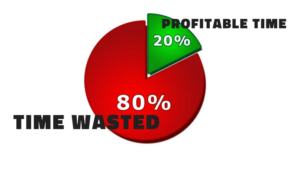
On average, twenty-percent of the workday is spent on important (read: profitable) tasks, while eighty-percent of the workday is wasted, yes, wasted on tasks that hold little, or no value.
Productivity is the main goal of any entrepreneur, trying to achieve a scalable income. If you aren’t being productive and efficient, you are wasting your time.

80 percent of time spent at work is not profitable
Unfortunately, Cornerstone Dynamics reveals that on average, twenty-percent of the workday is spent on important (read: profitable) tasks, while eighty-percent of the workday is wasted, yes, wasted on tasks that hold little, or no value (R).
Surprising, right?
Imagine for a moment if you increased your profitable work productivity.
You could actually double or triple your productivity easily and in many cases, this could dramatically increase your top line revenues and business profits.
So…
How does an entrepreneur swap those numbers and spend 80% or more time on profitable tasks?
And…
How does an entrepreneur even start to wade through the clutter of daily tasks, to garner importance?
After all, most business owners don’t intentionally fill their busy schedules with tasks that hold little or no value, right?
Fortunately, the solution isn’t a game show, so there isn’t a right door to peek behind.

The solution to time management as an entrepreneur isn’t as easy as selecting the right game show door. However, batching is a useful way to make the hours spent at work as productive as possible.
Instead, the solution is found in Batching.
Yes, batching.
Batching, though revolutionary to the entrepreneurial time-saving solutions is a simple concept to understand and implement.
In a guest post to Michael Hyatt’s blog, communications strategist, Joshua Leatherman (R), describes Batching as(R):
Batching is simply a form of time management that allows a person to maximize concentration and decrease distraction. As a result, it increases your productivity, creativity, and mental sharpness, while decreasing fatigue, procrastination, and stress.
Batching is setting aside intentional blocks of time for specific and intentional tasks and not allowing distractions or interruptions to break that focus. When batching, plan blocks of “break-time” between each block of focused tasks to help maintain focus and productivity.
When done right this can be something that dramatically changes how you work and it can allow you to get more done in half the time.
In fact, batching can be used to double your results, through rectifying mistakes, planning, and prioritizing tasks appropriately.
3 Quick & Easy Steps to Using Batching to Double Your Results
STEP #1: Rectifying Mistakes

The first step in batching a day’s work is to recognize the mistakes that are being made and rectify them.
Entrepreneurs want to use their time wisely, as there is only so much that can get done in a day.

It seems there’s never enough time to get everything done as a business owner. Time management can be accomplished however through methods such as batching.
But regardless of how time is prioritized, and tasks are organized, it seems there’s never enough time to get everything done.
In the end, entrepreneurs run around frantically trying to complete everything and get ahead of schedule. But ultimately, something always comes up. Thus, the hopes of finishing the daily to-do list are dashed for another day.
However, instead of doing the same thing over and over, the first step in batching a day’s work is to recognize the mistakes that are being made in the process.
Here are a few of the most common mistakes business owners make, while trying to organize their day:
Common Mistakes When it Comes to Organizing Your Day

When organizing your day try to avoid multi-tasking, not giving yourself enough time and over-scheduling.
Multi-Tasking (R)– While some people swear that multi-tasking is the key to productivity, there is a mountain of evidence to the contrary.
Splitting focus between important tasks not only ends up taking longer, it’s more frustrating because it’s taking so long! It’s not getting done to the best of the entrepreneur’s ability, because their attention is being spliced in multiple directions.
Not Giving Yourself Enough Time- There is never enough time in the day, mostly because entrepreneurs constantly underestimate the time it takes to perform a task.
According to Basecamp founder David Heinemeier, people should give twenty-five percent more time to a task then the time they believe it’s going to take. Everyone wants to be proactive and get as much done as they can throughout the workday. However, if you don’t give yourself enough time, you’re simply chasing your tail(R).
Give twenty-five percent more time to a task than the time you believe it’s going to take.
Over-Scheduling-Accurately allocating your time and talents is another skill that many entrepreneurs lack. Sure, there are only so many hours in the day and again, there’s so much that needs to get done.
However, by over-scheduling yourself, you’re undercutting your own advancements. If you underestimate the time it’s going to take for you to complete a task and you need to push it off until the next day, your whole week is now behind, instead of that one day.
Distractions- Distractions are the root of all time-management issues. According to a New York Times article, it can take up to twenty-five minutes to regain your focus after being distracted (and that doesn’t count the time it took to complete whatever it was that distracted you) (R).
According to a New York Times article, it can take up to twenty-five minutes to regain your focus after being distracted.

As an entrepreneur, you need to prioritize what needs to be handled now and what can wait.
Yet, between phones that constantly have notifications, friends and employee interruptions, and simply being a human being, distractions take us away from our tasks.
However, sometimes, when an urgent email comes in, it’s hard to even recognize it as a distraction. Although, remember that to everyone, when they want your attention, it is an emergency.
Therefore, as an entrepreneur, you need to prioritize what you, the owner of the business, need to handle immediately, and what can wait until your priorities are finished. This is why I recommend not checking your phone or email until a few hours after you start working. Aim to get the highest priorities done first before you ever check email, your phone or social media accounts. This alone will help you get way more done.
I also recommend you when you are working in blocks of time that you have your phone off or in airplane mode. You should also keep it out of sight so in a drawer or in the other room.
Step #2: Planning

Planning is the focus of being successful in batching
Planning is the focus of being successful at Batching. If you’re able to plan appropriately (and stick to that plan), you will start to see results almost immediately.
Benjamin Franklin famously said:
If you fail to plan, you plan to fail
Planning is the focus of being successful at Batching.
1. Schedule Out Your Day
The first step in a successful day, managed by batching, is to schedule out your day.
Take fifteen minutes, at the beginning of your day and plan it out. Better yet plan it out the night before, which is what I like to do. Business owners should have an overall plan for the week, but in the evening or morning, breaking up your daily tasks sets the mind toward the amount of work it has ahead of it.
I’ve been running a business online a long time and this one tip alone will dramatically change how you work and get things done.
2. Determine Which Tasks are Similar in Nature

The 2nd step to batching is to determine which tasks are similar.
The second step is to determine which tasks are similar in nature. Schedule, or batch these tasks consecutively.
According to Scott H. Young, by batching similar tasks together, it helps diminish the start and stop time dramatically and it improves focus (R). Because the tasks have a similar feel, the brain is not forced to shift from one random task to the next and so the workflow is more fluid. This way focus is more easily maintained.
Batching similar tasks together, helps diminish the start and stop time dramatically and it improves focus. – Scott H. Young
If you are currently switching from say emails to paid traffic campaigns, to email promotions, to running a webinar, to reviewing reports, to writing a blog post you are doing yourself a huge disservice.
3. GET TO WORK

The 3rd step to batching is to get to work.
Once the tasks are batched appropriately, the third step is to get to work.
Work in specific blocks of time and execute.
I prefer to work in 90-minute laser focused blocks of time.
Step #3: Prioritizing Tasks Appropriately

Prioritizing is a theme seen throughout the batching process. In business, priority equals profit.
Priority is a theme that is repetitious throughout the batching process.
Of course, you have your priorities, such as family, friends, and your business. Yet, prioritizing tasks are far more intense.
Priority in business equals profit from my experience.
Priority in business equals profit.
Therefore, it’s important to prioritize tasks in a way that completes the tasks that are directly profitable first.
I learned this years ago from bestselling author Robert G Allen when he taught me the concept of First Things First.
This basically means, the closer the task brings you to see a paycheck, the higher that task should be up on that list.
Or another way to look at is the first thing you should do every day are the most highly profitable tasks in your business.

When batching, the closer a task on your list brings you to see a paycheck, the higher that task should be up on that list.
After directly profitable tasks are finished, focus on tangent profitable tasks, which could be things like; meetings, emails, and phone calls.
I prefer to batch phone calls into one block of time with a short few minutes of break between each phone call. I also will batch all my notes for each of the calls before the calls start aiming to keep every call as short as it possibly can be without any distractions.
Tangent Profitable Tasks
Meetings- Despite what we may like to believe, meetings are often not the best use of time; especially as an entrepreneur. It takes time away from doing work, and is more of a checkup, to ensure everything is going okay.
Therefore, don’t make a meeting any longer than it must be. Meetings aren’t a time to be social. They are an occupational hazard and must be treated as such. Get in the meeting, get whatever needs to be accomplished over with and get out.
You should also set a clear agenda and clear meeting timeline so you stay focused and are forced to finish with a certain time period. Also, it’s best to set a meeting from my experience later in the day so folks can get their most productive and profitable work down first thing.

Tangent profitable tasks include meetings, answering and organizing emails, and making phone calls.
Email-Emails are better than meetings because you don’t have to travel to them, but besides that, they are electronic meetings.
The best way to prioritize emails is to use a filter and file system, so that specific clients, invoices, and other information can be sorted quickly and efficiently.
That way, they aren’t taking up space in your inbox (R). (This also keeps them Batched and organized.)
One thing I try to do (not always successfully) is to respond to emails twice per day at set times. I also am always looking for ways to outsource aspects of my inbox and soon will be experimenting with outsourcing my whole inbox.
Remember email is there to serve you not the other way around.
Phone Calls-There is much that can be efficiently accomplished with a phone call. While email is nice, there are a lot of business situations where they can be misconstrued. With a phone call, a question can be answered right then and there, without having to meet the person, which takes up far more of your valuable time.
Returning phone calls in a Batch formation is also good because you are already sworn into a rhythm. Therefore, the calls can be systematically taken care of, instead of hanging over your head all day, or week.
I prefer to do phone calls later in the day and usually aim to schedule them at the same time. Another good way to batch phone call meetings in one afternoon or day. For example, I have a friend that does all is phone calls, virtual meetings, and connecting on Fridays only each week.
Summary
To wrap things up, batching only works if the business owner is willing to restructure their day and learn from the mistakes they’ve made in the past. While batching is a simple concept, the practice of it, effectively, only works through dedication and self-discipline.
However, if batching is done in a productive, inciteful manner, it is sure to double your results faster than you could’ve imagined possible.
To learn more about batching check out Chris Ducker’s video on “Embracing the Power of Batching for Daily Productivity:”
Resources & References:
Time Management Stats that Might Surprise You: Cornerstone Dynamics
Communication Specialist Joshua Leatherman Describes Batching: Joshua Leatherman
How to Use Batching to Increase Results: Michael Hyatt’s Blog
How Task Batching Increases Productivity: Thrive Global
Tips on Time Management: Rescue Time
A Focus on Distraction: New York Times
20 Tips for Batching: Scott H. Young
The Trick to Organizing Gmail: PC World

